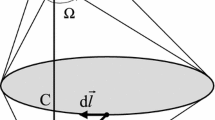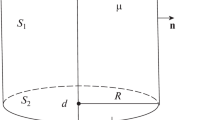Abstract
A conceptually simple result, which was recently derived for the circulation of the magnetic field created by a finite portion of wire carrying a slowly varying current, is used with the superposition principle and symmetry considerations to obtain an expression for the magnetic field of a thin cylindrical shell of finite length. This expression is combined with a new formula for an oblique solid angle, to obtain closed form solutions for the magnetic field created by the thin cylindrical shell segment in all regions of space. The solutions derived herein are applied in the limiting situations where the cylindrical shell’s length or radius is very large and compared to the known results for the magnetic field of a long conducting tube, and of an infinite plane, respectively. In addition, the use of physical principles of superposition and symmetry in this study is instructive from an educational perspective.





Similar content being viewed by others
References
Maxwell JC (1865) A dynamical theory of the electromagnetic field. Trans R Soc 155:459–512
Warburton FW (1954) Displacement current, a useless concept. Am J Phys 22:299–305
French AP, Tessman JR (1963) Displacement current and magnetic fields. Am J Phys 31:201–204
Terry WK (1982) The connection between the charged-particle current and the displacement current. Am J Phys 50:742–745
Griffiths DJ, Heald MA (1991) Time-dependent generalizations of the Biot-Savart and Coulomb laws. Am J Phys 59:111–117
Roche J (1998) The present status of Maxwell’s displacement current. Eur J Phys 19:155–166
Jackson JD (1999) Maxwell’s displacement current revisited. Eur J Phys 20:495–499
Charitat T, Graner F (2003) About the magnetic field of a finite wire. Eur J Phys 24:267–270
Arthur JW (2009) An elementary view of maxwell’s displacement current. IEEE Antennas Propag Mag 51:58–68
Heras JA (2011) A formal interpretation of the displacement current and the instantaneous formulation of Maxwell’s equations. Am J Phys 79:409–416
Morvay B, Pálfalvi L (2015) On the applicability of Ampère’s law. Eur J Phys 36:065014
Ferreira JM, Anacleto J (2013) Ampère-Maxwell’s law for a conducting wire: a topological perspective. Eur J Phys 34:1403–1410
Anacleto J, de Almeida JMMM, Ferreira JM (2012) Intrinsic symmetry of Ampère’s circuital law and other educational issues. Can J Phys 90:67–72
Oliveira MH, Miranda JA (2001) Biot-Savart-like law in electrostatics. Eur J Phys 22:31–38
Miranda JA (2000) Magnetic field calculation for arbitrarily shaped planar wires. Am J Phys 68:254–258
Strelkov S, El’tsin IA and Khaikin SE (1965) Problems in undergraduate physics, vol 2, Electricity and magnetism, 1st edn. Pergamon, London
Tipler PA (1991) Physics for Scientists and Engineers, extended version, 3rd edn. Worth Publishers, New York
Bose SK, Scott GK (1985) On the magnetic field of current through a hollow cylinder. Am J Phys 53:584–586
Griffiths DJ (2014) Introduction to electrodynamics, 4th edn. Pearson Education, Harlow
Li TT, Peng YJ (2000) Parameter identification in SP well-logging. Inverse Probl 16:357–372
Author information
Authors and Affiliations
Corresponding author
Appendix: Analytical solution for the solid angle defined by an oblique cone
Appendix: Analytical solution for the solid angle defined by an oblique cone
In the context of spontaneous well-logging parameter identification, Li and Peng [20] derived an analytical solution for the solid angle \(\omega \) defined by an oblique cone (in short ‘oblique solid angle’), which is only valid for \(R_{\mathrm{C}} >R\). As far as is known to us, no solution is available in the literature for \(R_{\mathrm{C}} <R\), the case shown in Fig. 6. In this Appendix, we derive a general analytical solution for the oblique solid angle \(\omega \) valid for all values of \(R_{\mathrm{C}} \) and R.
Shows positive oblique solid angle \(\omega \), \(0\le \omega \le 2\pi \). For the xyz coordinate system chosen, \(\omega \) is symmetrical about the xz-plane. Distances \(\left( {R, \,H} \right) \), circle radius \(\left( {R_{\mathrm{C}} } \right) \), polar coordinates \(\left( {\,\rho ,\theta } \right) \), \(\vec {r}\) being the position vector of elementary area \(\rho \mathrm{d}\theta \mathrm{d}\rho \) relative to the vertex V. If H is allowed to become very small, \(\omega \rightarrow 0\) for \(R_{\mathrm{C}} <R\) and \(\omega \rightarrow 2\pi \) for \(R_{\mathrm{C}} >R\)
From the definition of solid angle, for the choice of coordinate system in Fig. 6,
where \(\hat{{k}}\) is the unit vector along z, \(\mathrm{d}S=\rho \,\mathrm{d}\theta \,\mathrm{d}\rho \) is the infinitesimal area which subtends an elementary solid angle \(d\omega \) with vertex at \(\left( {-R,\;0,\;-H} \right) \), and \(\vec {r}\) is given by:
From (18) and (19), and the symmetry of the solid angle about the xz-plane (Fig. 6), we get:
Equation (20) can be written as:
and making the substitution \(u=\rho +R\cos \theta \) gives:
Integrating with respect to u the two standard integrals in (22) gives:
which can be solved and rearranged as:
The first integral in (24) is immediate. Since the integrand function in the third term in (24) is symmetrical about \(\pi /2\) in the interval of integration, one can integrate it as:
Inserting (25) into (24) gives the analytical solution for the oblique solid angle:
which is equivalent to Eqs. (7) and (8), being valid for all \(R_{\mathrm{C}} \).
Figure 7 shows the value of \(\omega \) as a function of H, for different values of \(R/{R_{\mathrm{C}} }\). For \({0<R}/{R_{\mathrm{C}} }<1\), \(\omega \) increases toward \(2\pi \), while for \(R/{R_{\mathrm{C}} }>1\), \(\omega \) always increases initially, reaches a maximum, and then decreases towards zero. For \(R/{R_{\mathrm{C}} }=1\), \(\omega \) increases, reaching the value of \(\pi \) when \(H=0\). It also shows that for any \(H\ne 0\), \(\omega \) varies continuously from a maximum, at \(R/{R_{\mathrm{C}} }=0\), toward 0 as \(R/{R_{\mathrm{C}} }\) approaches \(\infty \), whereas for \(H=0\), \(\omega \) exhibits a discontinuity of \(2\pi \) at \(R/{R_{\mathrm{C}} }=1\), where it has the value of \(\omega =\pi \). A complementary analysis can be made using Fig. 8, which shows the variation in \(\omega \) with \(R/{R_{\mathrm{C}} }\) for different values of H.
Plot of \(\omega \) as a function of H, for different values of \(R/{R_{\mathrm{C}} }\). For a given \(R/{R_{\mathrm{C}} }\), \(\omega \) is a continuous function of H. For a given \(H\ne 0\), \(\omega \) is a continuous function of \(R/{R_{\mathrm{C}} }\), but for \(H=0\), \(\omega \) exhibits a discontinuity at \(R=R_{\mathrm{C}} \)
Rights and permissions
About this article
Cite this article
Ferreira, J.M., Anacleto, J. Magnetic field created by a conducting cylindrical shell of finite length. Electr Eng 99, 979–986 (2017). https://doi.org/10.1007/s00202-016-0465-3
Received:
Accepted:
Published:
Issue Date:
DOI: https://doi.org/10.1007/s00202-016-0465-3







